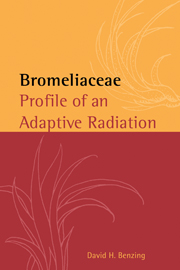Book contents
- Frontmatter
- Contents
- List of contributors
- Preface
- Acknowledgments
- Glossary
- Abbreviations
- Part one Brief overview
- Part two Basic structure, function, ecology and evolution
- 2 Vegetative structure
- 3 Reproductive structure
- 4 Carbon and water balance
- 5 Mineral nutrition
- 6 Reproduction and life history
- 7 Ecology
- 8 Relationships with fauna
- 9 History and evolution
- Part three Special topics
- Literature cited
- Name index
- Subject index
- Taxon index
9 - History and evolution
from Part two - Basic structure, function, ecology and evolution
Published online by Cambridge University Press: 19 January 2010
- Frontmatter
- Contents
- List of contributors
- Preface
- Acknowledgments
- Glossary
- Abbreviations
- Part one Brief overview
- Part two Basic structure, function, ecology and evolution
- 2 Vegetative structure
- 3 Reproductive structure
- 4 Carbon and water balance
- 5 Mineral nutrition
- 6 Reproduction and life history
- 7 Ecology
- 8 Relationships with fauna
- 9 History and evolution
- Part three Special topics
- Literature cited
- Name index
- Subject index
- Taxon index
Summary
Although evolution is the theme that ties this volume together, until now adaptive aspects of phenotype such as CAM, the phytotelm shoot and the absorbing trichome have dominated discussions. Times, places and why these features emerged during Bromeliaceae radiation have received far less attention. At this point, we switch emphasis to beginnings and circumstances that influenced the adoption of those characteristics that define much of the family as exceptional for adaptive novelty and importance in communities. Fossils, ontogeny, phytogeography, paleoclimate, cytogenetics and the structure of the genome provide insight on the geologic history and phylogeny of Bromeliaceae and point out directions for additional inquiry.
Phylogenetic analysis informed by the molecular structure of key segments of DNA and a fuller understanding of the morphology and adaptive biology of representative species will eventually reveal the identities and dates of the major evolutionary events responsible for the distinctness of the more advanced Bromeliaceae among Magnoliophyta. Conditions in primordial habitat(s) head the list of enduring questions: were these sites dark and humid like the forest understory or exposed and dry? More fundamentally, did scarcities of mineral nutrients or drought play the more decisive roles in the evolution of the foliar indumentum and phytotelm shoot? Heterochrony has also figured prominently in speculations about bromeliad radiation, but without much thought given to the incentives (plant benefits) responsible for this process.
A framework that arrays extant lineages in evolutionary space and geologic time (cladogram) will also resolve long-standing disagreements about taxonomy.
- Type
- Chapter
- Information
- BromeliaceaeProfile of an Adaptive Radiation, pp. 463 - 542Publisher: Cambridge University PressPrint publication year: 2000
- 3
- Cited by



